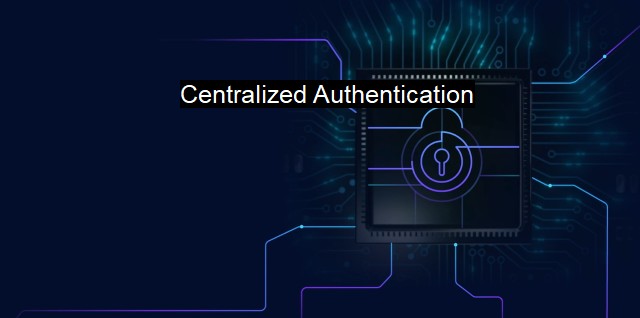What is Centralized Authentication?
Securing Networks with Centralized Authentication: The Importance of Single Sign-On (SSO) and Access Control in Cybersecurity and Antivirus Management
Centralized Authentication refers to an approach within cybersecurity where multiple systems rely on a single system to authenticate users or systems. Rather than having numerous individual systems perform their own authentication independently, everything is run through a single, centralized system. This streamlines the authentication process and increases security by ensuring conformity and consistency across all operations.Typically found in a client-server model infrastructure, centralized authentication can involve different authorization protocols like Kerberos, other securely shared secrets or public key certificates. Usually, authentication servers are dedicated machines and have their software specifically set up to handle authentication.
Authenticating via a centralized system represents significant administrative efficiency. When a company or organization adds, removes, or changes a user within the system, they only need to do it once, in one central location. This means fewer changes to keep track of hence a reduced likelihood of mistakes which could lead to security gaps and breaches.
Centralized authentication keeps things considerably tidier from a data and analytics perspective. Because everything runs through the same authentication hub, it's much simpler to collect and analyze the security-related data. Just one data set provides all the information an organization needs to know about authentication attempts on its system. This allows for an effective audit trail in case breaches occur, facilitating faster leak points identification and the immediate fixing of identified breaches.
Intertwining centralized authentication and antivirus systems can prove highly beneficial. As antivirus software is generally good at identifying and preventing known threats, integrating it with a centralized system manages both current and emergent threats. The antivirus program can quickly update and adapt against continually evolving threats as the centralized authentication keeps firm checks on who or what is gaining access to the overall system.
One often overlooked benefit of centralized authentication systems is with user experience. People can commonly feel overwhelmed when tasked with remembering different login credentials for multiple systems. With centralized authentication, a system called Single Sign-On (SSO) is often in place, where one set of credentials provides access to many different programs and systems. Hence, it simplifies the user experience significantly, consequently leading to a lower probability of security lapses like password sharing, storing passwords insecurely, or weak password usage.
Despite the benefits, centralized authentication does have potential risks. The most significant of these risks is that the centralized system itself might be targeted by cyber attackers. If the centralized authentication suffers a breach, that could potentially lead to unauthorized access to multiple systems or sensitive information. Therefore, organizations should implement robust security measures for their centralized authentication systems to minimize these risks. Frequent system patch updates, secure password storage, robust firewall systems, Intrusion Detection/Prevention Systems (IDPS), and strict adherence to cybersecurity best practices can prove useful in securing the centralized authentication system.
a centralized system requires a high degree of fault tolerance and availability. If the primary authentication server goes down, countless services could become inaccessible worldwide. Therefore, backup systems and redundancies need to be in place for seamless operations during such mishaps.
While centralized authentication does present risks, appropriate security measures can mitigate them. The advantages it provides in terms of improved security, administrative efficacy, analytics, user-friendly operations, and integration of antivirus measures make it an attractive solution for managing authentication protocols wide-scale. Its implementation must come along with a comprehensive and regularly updated cybersecurity strategy to secure the whole system from cyber threats.

Centralized Authentication FAQs
What is centralized authentication?
Centralized authentication is a method used in cybersecurity that allows users to access multiple systems and applications with a single set of login credentials.How does centralized authentication enhance a system's security?
Centralized authentication improves security by providing a single point of access control, which makes it easier to manage user accounts, monitor access logs, and enforce password policies. It also reduces the risk of credential theft and unauthorized access, as users only need to remember one set of credentials.What are some common examples of centralized authentication technologies?
Some common examples of centralized authentication technologies include LDAP (Lightweight Directory Access Protocol), Active Directory, and SAML (Security Assertion Markup Language). These technologies allow businesses to implement single sign-on (SSO) for their employees, which simplifies the login process and improves productivity.What are the benefits of using centralized authentication with antivirus software?
By integrating centralized authentication with antivirus software, organizations can enforce security policies more effectively and reduce the risk of malware infections. Centralized authentication can also provide administrators with greater visibility into user behavior, which can help them identify and remediate security incidents more quickly. Additionally, using centralized authentication with antivirus software can help reduce the administrative burden on IT staff by automating routine security tasks.| | A | | | B | | | C | | | D | | | E | | | F | | | G | | | H | | | I | | | J | | | K | | | L | | | M | |
| | N | | | O | | | P | | | Q | | | R | | | S | | | T | | | U | | | V | | | W | | | X | | | Y | | | Z | |
| | 1 | | | 2 | | | 3 | | | 4 | | | 7 | | | 8 | | |||||||